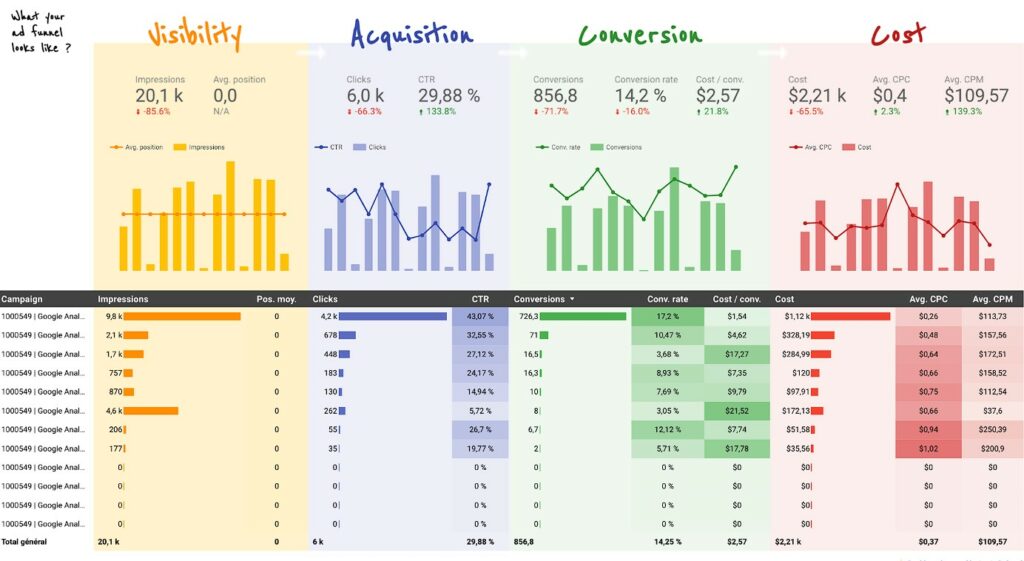Keys to boost your campaigns: important metrics in Google Ads

Do you find yourself investing in Google Ads but not seeing the expected results? Are you wondering how you can improve the performance of your campaigns and ensure a better ROI? You are not alone. Many companies jump into the world of online advertising with high expectations, only to find themselves faced with the complexity of optimizing their campaigns. Without a clear understanding of what metrics matter and how to interpret them, it’s easy to feel lost and give up prematurely.
In this article, we’ll dive into the most important metrics you should be monitoring in Google Ads to fine-tune your campaigns, improve their performance and ultimately reach your digital marketing goals more effectively.
Tabla de contenidos
Roads, one of the main metrics
Among the essential metrics to evaluate the performance of your Google Ads campaigns, Return on Ad Investment (ROAS) stands out as one of the first indicators you should consider. ROAS measures the relationship between the costs incurred on Google Ads and the revenue generated from these expenses, providing a clear view of the effectiveness of your campaigns in monetary terms.
Practical example of ROAS
Let’s imagine the following scenario to better understand how ROAS works:
- Total cost: €500
- Conversion value (revenue): €3000
To calculate ROAS, we divide the revenue generated by the cost of the campaign, which gives us a ROAS of 6 (3000 / 500 = 6).
This means that for every euro we spend on Google Ads, we are generating €6 in revenue. Undoubtedly, ROAS is positioned as one of my favorite metrics in Google Ads, as it offers a direct perspective on the return we are getting from our advertising investment.
By integrating ROAS into the analysis of your campaigns, you can gain a deeper understanding of their profitability. A high ROAS indicates that your campaigns are effective in generating revenue relative to ad spend, while a low ROAS may signal the need to optimize your ads, keywords or audience targeting to improve results.
Considering ROAS along with the other key metrics mentioned above will provide you with a comprehensive view of the performance of your Google Ads campaigns. By focusing on improving ROAS, you will be working directly on increasing the efficiency and profitability of your advertising efforts, ensuring that every dollar spent contributes significantly to your company’s financial goals.
Other important metrics you should review in Google ADS

Clicks and click-through rate (CTR)
A basic pillar to measure the interest your ads generate. A high CTR signals that your message resonates with your audience, while a low CTR could indicate the need to optimize your ad or ad targeting.
Impressions and impression share
The viewability of your ads is critical. These metrics help you understand how many times your ads are shown and how large your presence is compared to the total possible.
Impressions lost per budget and per ranking
Identifying why your ads are not being shown as much as they could be, whether due to budget constraints or low ranking, is key to making informed decisions on how to increase your visibility.
Cost per click (CPC) and cost per acquisition (CPA)
CPC and CPA allow you to evaluate the efficiency of your investment, showing you how much it costs to attract clicks and conversions, respectively. These metrics are crucial for managing your budget effectively.
Conversions and conversion rate
The ultimate goal of any campaign is to convert. These metrics show you how successful your ads are in driving the desired actions, from purchases to registrations on your website.
Ad Quality and Quality Score
High quality in your ads not only improves their position but can also reduce your cost per click. It is vital to understand how Google evaluates your ads to make continuous improvements.
Bonus: Review of search terms and Looker studio
Don’t forget the importance of reviewing the search terms that trigger your ads. This practice gives you valuable insights into how your audience searches for your products or services and how you can adjust your keywords to better capture that search intent.
Also remember to integrate Google Ads with Looker Studio to transform the analysis and presentation of metrics, not only for your campaigns but also for those of your clients. This combination enhances report customization, improves data visualization and provides real-time access to key indicators. Discover how the synergy between these tools can facilitate a deeper understanding and effective communication of advertising performance. Also, take advantage of the free Ads template available in Looker Studio to start optimizing your strategies today.
Here is the link to the template (you need to be registered in Looker Studio to view it) : Link to the template
Conclusion and FAQ
Monitoring and understanding these metrics will equip you with the knowledge you need to optimize your Google Ads campaigns. However, improving the performance of your ads is only one part of a comprehensive digital marketing strategy. Want to know how investing in Google Ads compares to other tactics like SEO? Visit our detailed article on Google Ads vs. SEO for insights that will help you make informed decisions about where to invest your marketing budget.
What is the most important metric in Google Ads?
All of the above metrics play a crucial role, depending on your specific goals. However, conversions and conversion rate are usually direct indicators of campaign success.
How can I improve my Google Ads quality score?
Optimize your ads by improving the relevance between your keywords, ads and landing page. A positive user experience on your site also contributes to a better score.
Should I focus on reducing my CPA or increasing my CTR?
It depends on your goals. If you’re looking for spending efficiency, focus on reducing CPA. If your goal is to increase visibility and interest in your offers, work on improving your CTR.
By understanding and acting on these key metrics, you will be in a stronger position to optimize your Google Ads campaigns and successfully achieve your digital marketing goals.


